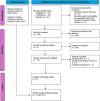Liberal transfusion strategies reduce sepsis risk and improve neurological recovery in acute brain injury: an updated systematic review and meta-analysis
- PMID: 40329392
- PMCID: PMC12057087
- DOI: 10.1186/s13054-025-05397-5
Liberal transfusion strategies reduce sepsis risk and improve neurological recovery in acute brain injury: an updated systematic review and meta-analysis
Abstract
Purpose: To advocate for a Liberal Transfusion Strategy (LTS) in neurocritical care patients with Acute Brain Injury (ABI) and provide updated evidence for optimizing transfusion thresholds in clinical guidelines.
Background: Anemia frequently complicates ABI management, often necessitating red blood cell transfusions. However, the optimal hemoglobin (Hb) threshold for transfusion remains controversial. While earlier meta-analyses indicated no significant differences between LTS and restrictive transfusion strategies (RTS), emerging randomized controlled trials (RCTs) emphasize the need for reappraisal within neurocritical care.
Methods: This meta-analysis included five RCTs involving 2399 patients (1,191 LTS; 1208 RTS) with ABI (subarachnoid hemorrhage, traumatic brain injury, or intracerebral hemorrhage). LTS was defined as transfusion at Hb ≤ 10-9 g/dL, and RTS as transfusion at Hb ≤ 7-8 g/dL. Outcomes assessed included sepsis or septic shock, ICU mortality, unfavorable functional outcomes at six months, venous thromboembolism (VTE), acute respiratory distress syndrome (ARDS), and in-hospital mortality.
Results: RTS significantly increased the risk of sepsis or septic shock (relative risk [RR]: 1.42; 95% confidence interval [CI] 1.08-1.86; p = 0.01) and unfavorable functional outcomes at six months (RR 1.13; 95% CI 1.06-1.21; p = 0.0003). No significant differences were observed in ICU mortality (RR 1.00; 95% CI 0.84-1.20; p = 0.96), VTE (RR: 0.88; 95% CI 0.56-1.38; p = 0.58), ARDS (RR 1.05; 95% CI 0.69-1.61; p = 0.81), or in-hospital mortality (RR 0.98; 95% CI 0.76-1.26; p = 0.89). Heterogeneity was minimal (I2 < 25%).
Conclusion: LTS demonstrates the potential to enhance safety and functional recovery in ABI patients by mitigating sepsis risk and promoting favorable neurologic outcomes. Further high-powered RCTs are warranted to validate these findings and refine transfusion protocols.
© 2025. The Author(s).
Conflict of interest statement
Declarations. Ethical approval and consent to participate: Not applicable. Consent for publication: Not applicable. Competing interests: All authors report no relationships that could be construed as a conflict of interest. All authors take responsibility for all aspects of the reliability and freedom from bias of the data presented and their discussed interpretation. Nothing to disclose.
Figures






References
-
- Dewan MC, Rattani A, Gupta S, Baticulon RE, Hung YC, Punchak M, et al. Estimating the global incidence of traumatic brain injury. J Neurosurg. 2019;130(4):1080–97. - PubMed
-
- Salim A, Hadjizacharia P, DuBose J, Brown C, Inaba K, Chan L, et al. Role of anemia in traumatic brain injury. J Am Coll Surg. 2008;207(3):398–406. - PubMed
-
- Litofsky NS, Martin S, Diaz J, Ge B, Petroski G, Miller DC, et al. The negative impact of anemia in outcome from traumatic brain Injury. World Neurosurg. 2016;90:82–90. - PubMed
Publication types
MeSH terms
LinkOut - more resources
Full Text Sources
Medical

